 |
// Источник: B.A.F. Newsletter, Ноябрь 2000, No 37
Although shiho-giri means literally 'four directions', it comes to mean all directions: a universal, spherical movement. In this exercise you cut to the front and to the rear with your arms while you are turning your body: a three dimensional movement. It is a very important exercise because it involves many essential elements of Aikido movement. At the start of the movement you have four points of contact: your two feet with the tatami and both your hands which are being grasped. But where are the limits of these four points? Swinging your arms up or down makes part of a circle. There is a maximum limit to your activity. Together, you and your partner, are in a capsule, so to speak. The principle of Aikido is no pushing no pulling. In one movement you and your partner keep together. It's a matter of harmony or blending (awase). Your centre must make contact with your partner's centre, while the contact point (your hands or arms) is going up and down. While doing this you should control your partner: he should not go out of your sphere of influence; nor should he come into yours. As we said, neither pushing nor pulling. Think about suwari-waza kokyu-ho: both of you are sitting face to face, and it's very clear that when your hands go up and out, you bring your partner up. The same principle applies to this exercise, the difference being that you change direction. 
1. Omote (表):Photo 1: Tori is standing in migi-hanmi (right posture) with his hands pointing upwards towards his adversary's eyes. Uke from the position of ai-hanmi takes hold of both of Tori's wrists {ryote-dori). There should be a feeling of tsuki (thrusting) as soon as contact is made, with energy flowing from your back foot towards your partner. This is not pushing but extending. Photos 2 & 3: Keeping this feeling, Tori turns slightly to his right and sliding his right foot he moves his body forwards, lowering his centre of gravity by lowering his shoulders and elbows and bending his knees, but at the same time swinging his arms upwards. Be careful to keep upright: if you do not move your centre correctly you will bend forwards. You should not be moving forwards before you affect your partner's stance. Notice that Uke's upper body (i.e shoulders) is already starting to rise and he is coming up onto his toes. Tori's left hand rotates with the thumb inwards, as though defending against a kick from Uke. His right hand also is rotating inwards and upwards against Uke's gripping wrist, pointing towards Uke's face. Now your arms expand outwards, your elbows rising. You should not be pushing your partner with your hands. Simply your body is turning outwards, leading out your partner's force. 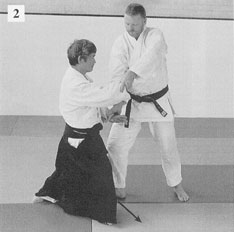
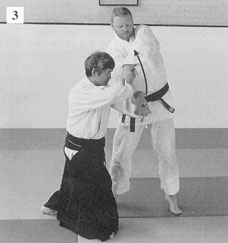
2. Ura (裏):
Shifting his weight onto his front foot, Tori makes tenkan with a strong feeling. Note the hands: they are exactly the same as in the exercise katate-dori solo tenkan (see Newsletter issue no. 36) and as at the beginning of ryote-dori Tenchi-nage ura (see Newsletter issue no. 30). He is keeping his left hand in his centre, turning the palm up, elbow not moving, with a feeling of tsuki, leading Uke's centre forwards with this left hand, even though he is stepping back. This is like the cut in swordwork which cuts the assailant's do (torso). Tori's right hand swings up, his te-gatana (hand-blade) making contact with the inside of Uke's wrist. It helps if you concentrale on your ring-finger its in (he suwari-waza kokyu-ho exercise. Keep both hands in the same line as your centre.
You must keep the contact and the stretching of your partner constant through your turning movement. In Photo 12 Tori has about 70% of his weight on his front (left) foot. In Photo 13 his weight is distributed evenly between his feet. In Photo 14 Tori has shifted 70% of his weight onto his right foot. Notice the strong supporting left leg, the ankle in contact with the tatami. Keep your posture upright (don't lean forwards). 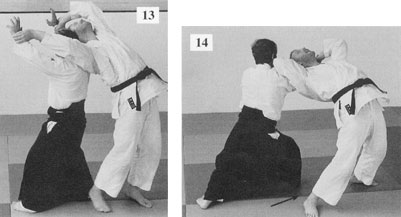
Hai-shin Undo (Back-stretch Exercises)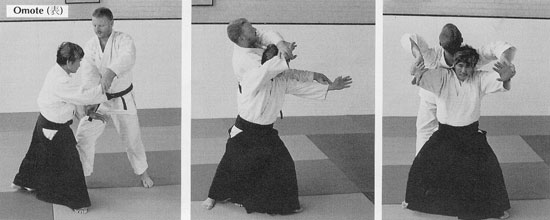 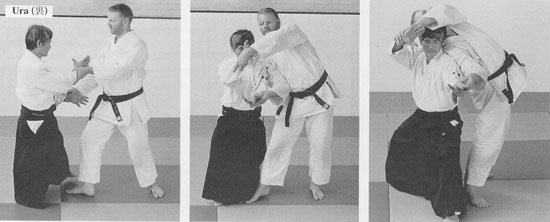
The movement omote and ura, are basically the same as in the Shiho-giri tenkan-ho we have been studying, the only difference being that we stop the tenkan half-way through. Be sure to make good contact with your partner from the very beginning, keeping him stretched and on his toes. With extended arms, your hands come up in front of your forehead. Turn your thumbs inwards and keep your fingers open. Don't bend forwards until you have good contact between your back and your partner's back. Then bend your knees and round your back as you incline forwards. Finally, come up slowly (don't suddenly relax). Your partner should maintain contact with your wrists until you are both upright again. |
||||||
| © Рюсинкан.ру |
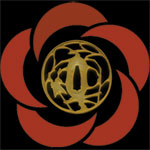

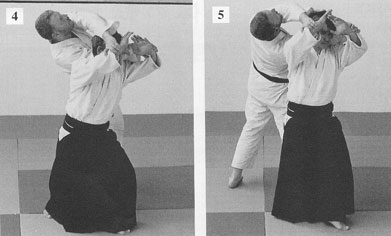 Photos 4 & 5: Making a large step forward with his left foot,
Photos 4 & 5: Making a large step forward with his left foot, 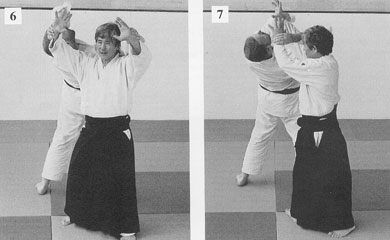 Photos 6 & 7:
Photos 6 & 7: 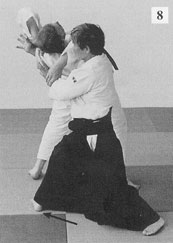 Photo 8: At the end of the turn,
Photo 8: At the end of the turn, 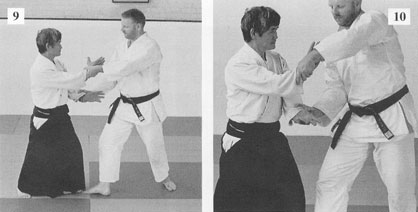
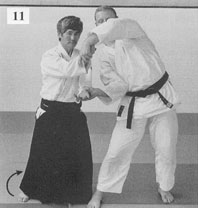 Photos 9-11: When our partner is pulling we respond with the
Photos 9-11: When our partner is pulling we respond with the 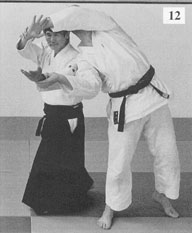 Photos 12 - 14: As
Photos 12 - 14: As 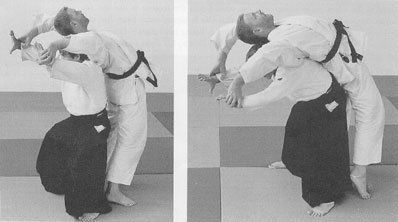 Although we regularly do these exercises at the end of a practice, they are very important movements, embodying the essential elements of control from beginning to end which we must apply to all Aikido techniques.
Although we regularly do these exercises at the end of a practice, they are very important movements, embodying the essential elements of control from beginning to end which we must apply to all Aikido techniques.